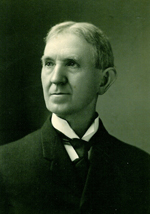William H. Whitsitt: 1895-1899
William Heth Whitsitt, Southern’s third president, was born on November 25, 1841, in Nashville, Tennessee. His election to the presidential office came on May 9, 1895, but it would prove to be the seminary’s shortest tenure to date.
In 1857, Whitsitt entered Union University, where he earned a B.A. and an M.A., and graduated with honors. Whitsitt served in the Confederate army as a fighting chaplain. Following the war, Whitsitt undertook further postgraduate study at the University of Virginia, Southern, and the University of Berlin. Southern then called Whitsitt back to Greenville in 1872 to teach Hebrew and biblical instruction. Whitsitt’s main subject, however, was church history. Among other projects, he composed a 1400 page biography of Mormon pioneer Sidney Rigdon, whom Whitsitt saw as the true founder of Mormonism. Whitsitt won a reputation as a lecturer possessing terse style and pithy phrases. “I would rather have ten words written on the spot,” he once opined, “than a cartload of reminisces.” (1) The professor married Florence Wallace of Woodford County, Kentucky in October 1881. The marriage produced a daughter and son.
Whitsitt became popular among students for engaging them in the historical curiosities that first interested him. One such interest led to an 1893 article in Johnson’s Universal Encyclopedia that generated contentious debate with Southern Baptists who identified with the “Landmark” tenets of J. R. Graves, although most Southern Baptists remained unfamiliar with the article until after Whitsitt’s election to the seminary presidency. In the article, Whitsitt argued that the practice of believer’s baptism by immersion began in seventeenth century England (no earlier 1641) and that Roger Williams’s church in Rhode Island did not initially immerse. Landmarkists held that an unbroken succession of immersion baptisms from the apostolic era, a necessary basis for the existence of true churches. If the chain was broken, there were no more baptisms and no more churches. In 1895, as the controversy was beginning, the Southern trustees elected Whitsitt the seminary’s third president. Their hopes that the dispute over Landmarkism would die away were soon dashed as the disagreement grew to a furious pitch even as Whitsitt attempted to clarify his position in speech and print, most notably his 1896 book A Question in Baptist History. Landmark leaders threatened schism. Enrollment fell. Under threats by various churches and donors to withhold financial giving to the seminary, Whitsitt tendered his letter of resignation to seminary trustee chairman Joshua Levering on July 13, 1898, which became officially effective the following year when the full trustee body assembled prior to the Southern Baptist Convention’s 1899 annual meeting.
Following his departure from Southern, Whitsitt joined the University of Richmond in 1901 as a professor of philosophy and continued in that role until 1911. In a statement made before he left Southern, Whitsitt summed up his life’s philosophy, sharing that “my heart and life are bound up with the Baptists and I have no higher thought on earth than to spend my days in their fellowship and service, in the name of the Lord Jesus Christ.” (2) He died peacefully in Virginia in 1911.
(1) Bill Leonard, “Student Life at Southern Seminary,” Review and Expositor, 1984, 443. (2) William Mueller, A History of Southern Baptist Theological Seminary, 166-67.
Sources: William Mueller, A History of Southern Baptist Theological Seminary, Nashville, TN: Broadman, 1959; James H. Slatton, W. H. Whitsitt: The Man and the Controversy (Mercer University Press, 2009).

